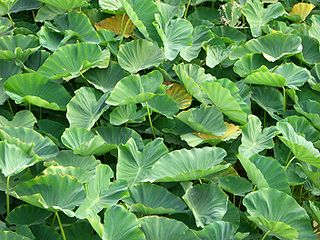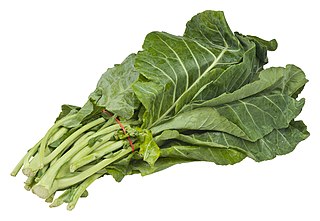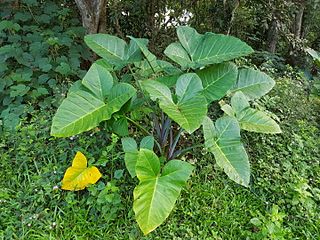
Colocasia is a genus of flowering plants in the family Araceae, native to southeastern Asia and the Indian subcontinent. Some species are widely cultivated and naturalized in other tropical and subtropical regions.

Spinach is a leafy green flowering plant native to central and western Asia. It is of the order Caryophyllales, family Amaranthaceae, subfamily Chenopodioideae. Its leaves are a common edible vegetable consumed either fresh, or after storage using preservation techniques by canning, freezing, or dehydration. It may be eaten cooked or raw, and the taste differs considerably; the high oxalate content may be reduced by steaming.

Root vegetables are underground plant parts eaten by humans as food. Although botany distinguishes true roots from non-roots, the term "root vegetable" is applied to all these types in agricultural and culinary usage.

A corm, bulbo-tuber, or bulbotuber is a short, vertical, swollen underground plant stem that serves as a storage organ that some plants use to survive winter or other adverse conditions such as summer drought and heat (perennation).

Collard is a group of certain loose-leafed cultivars of Brassica oleracea, the same species as many common vegetables including cabbage and broccoli. Collard is generally described as part of the Acephala (kale) cultivar group, but gets its own variety as Brassica oleracea var. viridis. The name "collard" comes from the word "colewort".

Xanthosoma is a genus of flowering plants in the arum family, Araceae. The genus is native to tropical America but widely cultivated and naturalized in other tropical regions. Several are grown for their starchy corms, an important food staple of tropical regions, known variously as malanga, otoy, otoe, cocoyam, tannia, tannier, yautía, macabo, ocumo, macal, taioba, dasheen, quequisque, ʻape and as Singapore taro. Many other species, including especially Xanthosoma roseum, are used as ornamental plants; in popular horticultural literature these species may be known as ‘ape due to resemblance to the true Polynesian ʻape, Alocasia macrorrhizos, or as elephant ear from visual resemblance of the leaf to an elephant's ear. Sometimes the latter name is also applied to members in the closely related genera Caladium, Colocasia (taro), and Alocasia.

Leaf vegetables, also called leafy greens, pot herbs, vegetable greens, or simply greens, are plant leaves eaten as a vegetable, sometimes accompanied by tender petioles and shoots. Leaf vegetables eaten raw in a salad can be called salad greens.

Basella alba is an edible perennial vine in the family Basellaceae. It is found in tropical Asia and Africa where it is widely used as a leaf vegetable. It is native to the Indian subcontinent, Southeast Asia and New Guinea. It is naturalized in China, tropical Africa, Brazil, Belize, Colombia, Philippines, the West Indies, Fiji and French Polynesia.

Taro is a root vegetable. It is the most widely cultivated species of several plants in the family Araceae that are used as vegetables for their corms, leaves, and petioles. Taro corms are a food staple in African, Oceanic, and South Asian cultures. Taro is believed to be one of the earliest cultivated plants.

Callaloo is a popular Caribbean vegetable dish. There are many variants across the Caribbean, depending on the availability of local vegetables. The main ingredient is an indigenous leaf vegetable, traditionally either amaranth, taro leaves or Xanthosoma leaves.

Cocoyam is a common name for more than one tropical root crop and vegetable crop belonging to the Arum family and may refer to:

Eddoe or eddo is a tropical vegetable often considered identifiable as the species Colocasia antiquorum, closely related to taro, which is primarily used for its thickened stems (corms). In most cultivars there is an acrid taste that requires careful cooking. The young leaves can also be cooked and eaten, but they have a somewhat acrid taste.

Cnidoscolus aconitifolius, commonly known as chaya, tree spinach, or spinach tree, is a large, fast-growing and leafy perennial shrub that is believed to have originated in the Yucatán Peninsula of Mexico. The specific epithet, aconitifolius, means "Aconitum-like leaves". It has succulent stems that exude a milky sap when cut.

Alternanthera sessilis is a flowering plant known by several common names, including sissoo spinach, Brazilian spinach, sessile joyweed, dwarf copperleaf, and mukunuwenna in Sri Lanka. It is cultivated as a vegetable worldwide.
Ground provisions is the term used in West Indian nations to describe a number of traditional root vegetable staples such as yams, sweet potatoes, dasheen root (taro), eddos and cassava. They are often cooked and served as a side dish in local cuisine. Caribbean recipes will often simply call for ground provisions rather than specify specific vegetables.
Perennial vegetables are vegetables that can live for more than two years.

Xanthosoma sagittifolium, the arrowleaf elephant ear, arrowleaf elephant's ear, malanga or American taro, is a species of tropical flowering plant in the genus Xanthosoma, which produces an edible, starchy corm. Cultivars with purple stems or leaves are also variously called blue taro, purplestem taro, purplestem tannia, and purple elephant's ear among others. Taro is a different species that belongs to the genus Colocasia.

Forage and farm-based foods have long been combined in Fijian cuisine. Although rice, wheat, and tea have all been staples during the colonial era, the native Fijians still eat primarily tubers and coconuts in their diet. Native Americans have farmed higher calorie foods like cassava, taro, and yams for thousands of years. The cuisine of Fiji is renowned for its seafood and various green vegetables, including Ota, a young forest fern that is collected for consumption, and Bele, a plant that resembles spinach and is also known as slippery cabbage.

Native Hawaiian cuisine refers to the traditional Hawaiian foods that predate contact with Europeans and immigration from East and Southeast Asia. The cuisine consisted of a mix of indigenous plants and animals as well as plants and animals introduced by Polynesian voyagers, who became the Native Hawaiians.
















